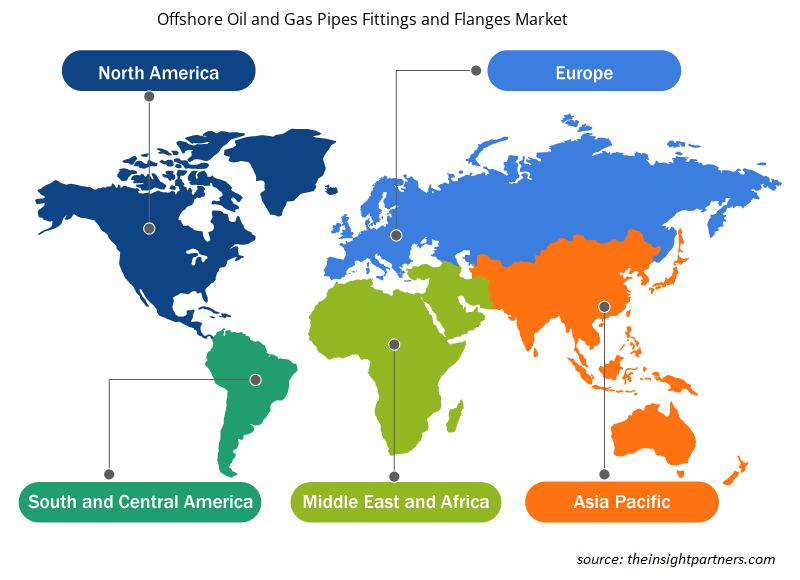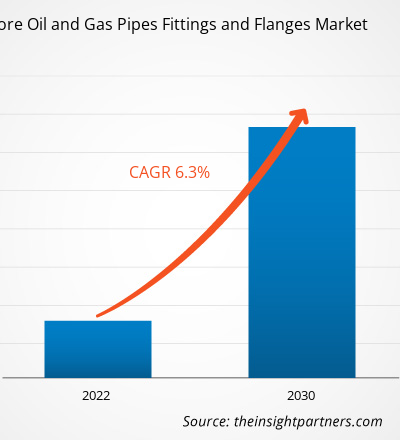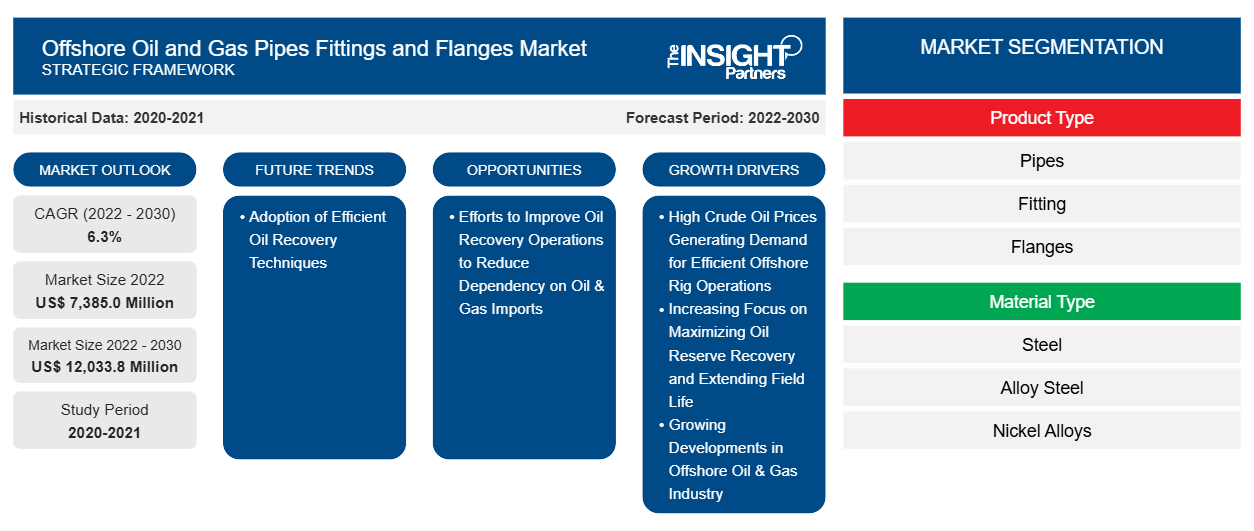Der Markt für Offshore-Öl- und Gasrohrverbindungen und -flansche soll von 7.385,0 Millionen US-Dollar im Jahr 2022 auf 12.033,8 Millionen US-Dollar im Jahr 2030 anwachsen. Der Markt soll zwischen 2022 und 2030 eine durchschnittliche jährliche Wachstumsrate (CAGR) von 6,3 % verzeichnen. Zu den wichtigsten Trends, die den Markt für Offshore-Öl- und Gasrohrverbindungen und -flansche antreiben, zählen die zunehmende Offshore-Öl- und Gasproduktion, die steigende Produktion neuer Offshore-Ölbohranlagen und der Umbau bestehender und alter Offshore-Öl- und Gasbohranlagen.
Marktanalyse für Offshore-Öl- und Gasrohre, Formstücke und Flansche
Der Markt für Offshore-Öl- und Gasrohrverbindungen und -flansche dürfte im analysierten Zeitraum aufgrund der steigenden Zahl von Offshore-Erdgasprojekten sowie der Entdeckung neuer Offshore-Ölfelder, insbesondere an abgelegenen Standorten, ein beträchtliches Wachstum verzeichnen. Darüber hinaus hat die Erschöpfung der bestehenden Öl- und Gasreserven in verschiedenen Ländern eine Nachfrage nach grenzüberschreitenden Pipelines für die Versorgung mit Öl- und Gasprodukten geschaffen, was das Wachstum des Marktes für Offshore-Öl- und Gasrohrverbindungen und -flansche ankurbelt. Die steigende Nachfrage nach kostengünstigen Transportmethoden für Öl und Gas ist einer der Hauptfaktoren, die voraussichtlich die Nachfrage nach Offshore-Rohrverbindungen und -flanschen im Öl- und Gassektor in Übersee weltweit ankurbeln werden.
Marktübersicht für Rohrverbindungen und Flansche für Offshore-Öl- und Gasindustrie
Mit der wachsenden Bevölkerung und Industrialisierung steigt auch der Energiebedarf auf globaler Ebene. Der Anstieg des Energieverbrauchs steigerte auch den Bedarf an Öl und Gas in Entwicklungs- und Industrieländern. Dies hat zu einer steigenden Nachfrage nach Offshore-Infrastruktur auf der ganzen Welt geführt, was wiederum den Markt für Offshore-Öl- und Gasrohre, -Armaturen und -Flansche ankurbeln dürfte. Darüber hinaus treiben die große Bevölkerung, das hohe Pro-Kopf-Einkommen und die schnelle Industrialisierung die Nachfrage nach Öl und Gas an, was wiederum den Markt für Offshore-Öl- und Gasrohre, -Armaturen und -Flansche weltweit ankurbeln dürfte.
Passen Sie diesen Bericht Ihren Anforderungen an
Sie erhalten kostenlos individuelle Anpassungen an jedem Bericht, einschließlich Teilen dieses Berichts oder einer Analyse auf Länderebene, eines Excel-Datenpakets sowie tolle Angebote und Rabatte für Start-ups und Universitäten.
- Holen Sie sich die wichtigsten Markttrends aus diesem Bericht.Dieses KOSTENLOSE Beispiel umfasst eine Datenanalyse von Markttrends bis hin zu Schätzungen und Prognosen.
Markttreiber und Chancen für Offshore-Öl- und Gasrohrverbindungen und -flansche
Die steigende Nachfrage nach Erdgas und Rohöl dürfte der Haupttreiber für den Markt für Offshore-Öl- und Gasrohre, Fittings und Flansche sein
Die Nachfrage nach Öl und Erdgas steigt weltweit stetig an. Die USA und Großbritannien verzeichneten das stärkste Wachstum. Der starke Anstieg der Nachfrage nach Petrochemikalien in den USA führte zu einem erhöhten Verbrauch. Der Anstieg der Industrieproduktion sowie die hohe Nachfrage nach Transportdienstleistungen kurbeln die Nachfrage nach Petrochemikalien an und befeuern damit das Wachstum des Marktes für Offshore-Öl- und Gasrohrverbindungen und -flansche. Darüber hinaus ist das weltweite Wachstum des Luftverkehrs, insbesondere in den Entwicklungsländern Asiens, ein weiterer wichtiger Faktor, der zu einem erhöhten Ölverbrauch führt.
Die Organisation erdölexportierender Länder (OPEC) veröffentlichte im Oktober 2020 den „OPEC World Oil Outlook 2020“. Dem Ausblick zufolge führte der Ausbruch der COVID-19-Pandemie zu einem Rückgang der Ölnachfrage; es wurde jedoch erwartet, dass der globale Energiebedarf in Zukunft stetig wachsen und bis 2045 um bemerkenswerte 25 % steigen würde. Der Ausblick geht ferner davon aus, dass Öl der größte Beitragszahler im Energiemix sein wird und bis 2045 27 % des gesamten Energieanteils ausmachen wird. Der Bedarf an Ölprodukten wird in den OECD-Ländern im Zeitraum 2022–2025 schätzungsweise um mehr als 47 mb/Tag steigen. Andererseits wird der Bedarf in Nicht-OECD-Ländern im Prognosezeitraum bis 2045 voraussichtlich um 22,5 mb/Tag steigen.
Bemühungen zur Verbesserung der Ölförderung, um die Abhängigkeit von Öl- und Gasimporten zu verringern
Die Dampfinjektion wurde in den letzten Jahrzehnten kommerziell genutzt, um die Förderung aus konventionellen Schweröllagerstätten in ihren späteren Entwicklungsstadien zu verbessern. Der eingespritzte Dampf erhöht den Gesamtdruck einer Offshore-Öllagerstätte, was dazu beiträgt, die Mobilitätsrate des Rohöls zu verbessern und ein effizientes Fließen zu ermöglichen. Infolgedessen tragen die verbesserten Ölgewinnungsmethoden dazu bei, die Förderprozesse in bestehenden Offshore -Ölquellen zu revitalisieren. Verschiedene Länder investieren in die Erneuerung ihrer bestehenden Ölressourcen, um die heimische Ölproduktion anzukurbeln und ihre Abhängigkeit von Ölimporten zu verringern. Daher wird erwartet, dass die geplante Ausweitung ihrer Öl- und Gasaktivitäten den Akteuren auf dem Markt für Offshore-Öl- und Gasrohre, -Armaturen und -Flansche in den kommenden Jahren vielversprechende Wachstumschancen bietet.
Segmentierungsanalyse des Marktberichts zu Offshore-Öl- und Gasrohren, Armaturen und Flanschen
Wichtige Segmente, die zur Ableitung der Marktanalyse für Formstücke und Flansche für Offshore-Öl- und Gasleitungen beigetragen haben, sind Produkttyp und Materialtyp.
- Basierend auf dem Produkttyp wurde der Markt für Offshore-Öl- und Gasrohrverbindungen und -flansche in Rohre, Verbindungen und Flansche unterteilt. Das Rohrsegment hatte im Jahr 2022 einen größeren Marktanteil.
- Basierend auf dem Materialtyp wurde der Markt für Offshore-Öl- und Gasrohrverbindungen und -flansche in Stahl, legierten Stahl, Nickellegierungen und Kupferlegierungen unterteilt. Das Stahlsegment hatte im Jahr 2022 einen größeren Marktanteil.
Marktanteilsanalyse für Offshore-Öl- und Gasrohre, Formstücke und Flansche nach geografischen Gesichtspunkten
Der geografische Umfang des Marktberichts für Offshore-Öl- und Gasrohrverbindungen und -flansche ist hauptsächlich in fünf Regionen unterteilt: Nordamerika, Europa, Asien-Pazifik, Naher Osten und Afrika sowie Südamerika.
Europa hat den Markt für Offshore-Öl- und Gasrohre, Fittings und Flansche im Jahr 2023 dominiert. Die europäische Region umfasst Deutschland, Norwegen, Italien, Russland, Großbritannien und den Rest Europas. Das Wachstum der Offshore-Aktivitäten ist opportunistisch für das Wachstum des Pipeline-Marktes in Europa. Darüber hinaus wird erwartet, dass die Erholung der Volkswirtschaften in ganz Europa in den kommenden Jahren das Wachstum der Nachfrage nach Öl und Gas vorantreiben wird. Europa ist der zweitgrößte Produzent von Erdölprodukten weltweit und verfügt weiterhin über eine Ölraffineriekapazität von mehr als 15 % der Gesamtmenge. Die Gasindustrie in Europa hat aufgrund der steigenden europäischen LNG-Nachfrage verschiedene Verschiebungen erlebt. Die Regierungsstellen haben verschiedene Schritte unternommen, um Bekanntmachungen zu machen, darunter zahlreiche britische Industrien, darunter Öl und Gas. Norwegen und Russland haben weiterhin ihre Position als Erdgaslieferanten behauptet, während Deutschland, Frankreich und Italien die Hauptimporteure von Erdgas sind. Daher würde eine große Anzahl von Offshore-Projekten für Öl und Gas auch die Nachfrage nach Rohren, Fittings und Flanschen sowie Dienstleistungen beschleunigen.
Regionale Einblicke in den Markt für Offshore-Rohrverbindungen und -Flansche
Die regionalen Trends und Faktoren, die den Markt für Offshore-Öl- und Gasrohrverbindungen und -flansche während des gesamten Prognosezeitraums beeinflussen, wurden von den Analysten von Insight Partners ausführlich erläutert. In diesem Abschnitt werden auch die Marktsegmente und die Geografie von Offshore-Öl- und Gasrohrverbindungen und -flanschen in Nordamerika, Europa, im asiatisch-pazifischen Raum, im Nahen Osten und Afrika sowie in Süd- und Mittelamerika erörtert.

- Erhalten Sie regionale Daten zum Markt für Offshore-Rohrverbindungen und -Flansche für Öl und Gas
Umfang des Marktberichts über Rohrverbindungen und Flansche für Offshore-Öl- und Gasindustrie
| Berichtsattribut | Details |
|---|---|
| Marktgröße im Jahr 2022 | 7.385,0 Millionen US-Dollar |
| Marktgröße bis 2030 | 12.033,8 Millionen US-Dollar |
| Globale CAGR (2022 - 2030) | 6,3 % |
| Historische Daten | 2020-2021 |
| Prognosezeitraum | 2022–2030 |
| Abgedeckte Segmente | Nach Produkttyp
|
| Abgedeckte Regionen und Länder | Nordamerika
|
| Marktführer und wichtige Unternehmensprofile |
|
Marktteilnehmerdichte für Offshore-Öl- und Gasrohre, Armaturen und Flansche: Auswirkungen auf die Geschäftsdynamik verstehen
Der Markt für Offshore-Öl- und Gasrohre, Fittings und Flansche wächst rasant, angetrieben durch die steigende Endverbrauchernachfrage aufgrund von Faktoren wie sich entwickelnden Verbraucherpräferenzen, technologischen Fortschritten und einem größeren Bewusstsein für die Vorteile des Produkts. Mit steigender Nachfrage erweitern Unternehmen ihr Angebot, entwickeln Innovationen, um die Bedürfnisse der Verbraucher zu erfüllen, und nutzen neue Trends, was das Marktwachstum weiter ankurbelt.
Die Marktteilnehmerdichte bezieht sich auf die Verteilung der Firmen oder Unternehmen, die in einem bestimmten Markt oder einer bestimmten Branche tätig sind. Sie gibt an, wie viele Wettbewerber (Marktteilnehmer) in einem bestimmten Marktraum im Verhältnis zu seiner Größe oder seinem gesamten Marktwert präsent sind.
Die wichtigsten auf dem Markt für Rohrverbindungen und Flansche für die Offshore-Öl- und Gasindustrie tätigen Unternehmen sind:
- US-Metalle
- LFF-Gruppe
- Weitere Informationen finden Sie unter:
- Alliance Rohre und Armaturen
- AFG Holdings, Inc.
- Flanschenwerk Bebitz GmbH
Haftungsausschluss : Die oben aufgeführten Unternehmen sind nicht in einer bestimmten Reihenfolge aufgeführt.

- Überblick über die wichtigsten Akteure auf dem Markt für Offshore-Rohrleitungen, Armaturen und Flansche für Öl- und Gasleitungen
Marktnachrichten und aktuelle Entwicklungen zu Rohrverbindungen und Flanschen für Offshore-Öl- und Gasleitungen
Der Markt für Offshore-Öl- und Gasrohrverbindungen und -flansche wird durch die Erfassung qualitativer und quantitativer Daten nach Primär- und Sekundärforschung bewertet, die wichtige Unternehmensveröffentlichungen, Verbandsdaten und Datenbanken umfasst. Im Folgenden finden Sie eine Liste der Entwicklungen auf dem Markt für Offshore-Öl- und Gasrohrverbindungen und -flansche sowie der Strategien:
- Im Juli 2023 erhielt Vallourec zwei Großaufträge zur Lieferung von Rohrleitungen für die Phasen 6 und 8 der von Petrobras betriebenen Ölfeldentwicklung von Buzios. Diese Aufträge kommen zu dem vorherigen Vertrag für Phase 7 hinzu und umfassen insgesamt 48.000 Tonnen Rohrleitungen.
- Im Juni 2021 gab AFG Holdings, Inc. bekannt, dass es die Anteile der Maass Flange Corporation und ihrer Tochterunternehmen in Mexiko und Kanada erworben hat. Die Maass Flange Corporation ist der größte inländische Zulieferer von Flanschen aus Edelstahl und Nickellegierungen in Nordamerika.
Marktbericht zu Rohrverbindungen und Flanschen für Offshore-Öl- und Gasindustrie – Umfang und Ergebnisse
Der Bericht „Marktgröße und Prognose für Offshore-Öl- und Gasrohre, Formstücke und Flansche (2020–2030)“ bietet eine detaillierte Analyse des Marktes, die die folgenden Bereiche abdeckt:
- Marktgröße und Prognose auf globaler, regionaler und Länderebene für alle wichtigen Marktsegmente, die im Rahmen des Projekts abgedeckt sind
- Marktdynamik wie Treiber, Beschränkungen und wichtige Chancen
- Wichtige Zukunftstrends
- Detaillierte Porter's Five Forces Analyse
- Globale und regionale Marktanalyse mit wichtigen Markttrends, wichtigen Akteuren, Vorschriften und aktuellen Marktentwicklungen
- Branchenlandschaft und Wettbewerbsanalyse, einschließlich Marktkonzentration, Heatmap-Analyse, prominenten Akteuren und aktuellen Entwicklungen
- Detaillierte Firmenprofile mit SWOT-Analyse
- Historische Analyse (2 Jahre), Basisjahr, Prognose (7 Jahre) mit CAGR
- PEST- und SWOT-Analyse
- Marktgröße Wert/Volumen – Global, Regional, Land
- Branchen- und Wettbewerbslandschaft
- Excel-Datensatz
Aktuelle Berichte
Verwandte Berichte
Erfahrungsberichte
Grund zum Kauf
- Fundierte Entscheidungsfindung
- Marktdynamik verstehen
- Wettbewerbsanalyse
- Kundeneinblicke
- Marktprognosen
- Risikominimierung
- Strategische Planung
- Investitionsbegründung
- Identifizierung neuer Märkte
- Verbesserung von Marketingstrategien
- Steigerung der Betriebseffizienz
- Anpassung an regulatorische Trends





















 Kostenlose Probe anfordern für - Markt für Offshore-Öl- und Gasrohre, Fittings und Flansche
Kostenlose Probe anfordern für - Markt für Offshore-Öl- und Gasrohre, Fittings und Flansche